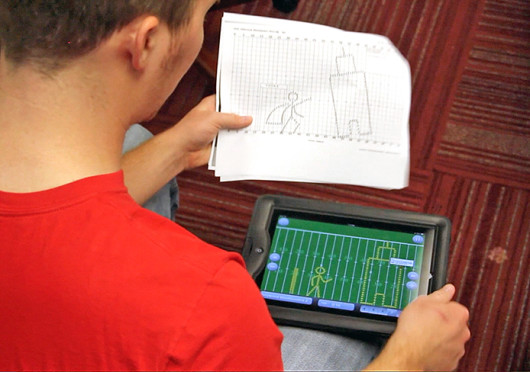
Charlie King, a sixth-year in computer information and science, compares his iPad’s chart to a printed chart.
Credit: Shelby Lum / Photo editor
For five years, he marched alongside the trumpets of T-row, performed in Skull Sessions and was a part of the Script Ohio formation. Charlie King, a sixth-year in computer information and science, though, is attempting to fulfill the band’s motto of “tradition through innovation” in a new way.
King was the squad leader for T-row, one of the band’s trumpet rows, in 2011 before resuming his role as a regular member in 2012. But this year, King has taken a new role with OSU Marching Band as its student staff IT manager. He said he saw room for improvement with the implementation of tablets and jumped at the opportunity to create something better.
But he didn’t just assume his idea to incorporate iPads into the band’s routine would go over flawlessly.
“I was trying to be pessimistic about the whole thing so we could prepare for anything,” King said. “(Being pessimistic) helped because I was ready for the disappointments that came up.”
The idea started online, with King proposing a “smart band room” that would use tablets instead of paper to some band members via Facebook message. King said the tablet would automatically update changes to music and charts and would save time, resources and more than $20,000 a year on printing.
He and bandmate Ryan Barta, who also plays trumpet and is a fourth-year in business, began brainstorming and soon realized their idea could become a reality.
The duo collaborated on the project with Barta focusing on the proposal and execution, and King targeting technology and training.
After addressing potential problems, including protecting the iPads with waterproof cases, they received the go-ahead from band director Jon Waters. They then proposed the idea to Digital First learning technology manager Cory Tressler in March.
“King and Barta’s iPad project plan was more developed than 95 percent of the … plans I have ever seen,” Tressler said. “They really did their research and thought through various elements and anyone who saw their presentation instantly felt the excitement that they brought with the plan.”
Digital First aims to increase the use of technology for learning on campus through projects like creating iTunes U courses, improving wireless Internet and helping various OSU departments and colleges implement iPads.
The pilot project includes 45 iPads given to squad leaders, administrative staff and directors. King and Barta installed Dropbox, Google Drive and other apps to share music and charts.
Squad leaders have already begun using the iPad’s capabilities in their own ways, something that came as a surprise to King.
“We found that they started doing more than we thought that would happen,” King said.
For example, some squad leaders filmed prospective band members during summer sessions performing drills with the iPads, then played the footage while providing feedback on their marching.
“That was a huge innovation we saw right out of the gate,” King said.
King said the project has sparked the interest of Apple Inc. CEO Tim Cook.
Mike Hofherr, interim OSU chief information officer, heard about Apple’s interest in the project, King said.
“(Hofherr) has been really helpful to us and very supportive of the project,” King said.
A request for comment from Hofherr was forwarded to OSU assistant vice president of media and public relations Gayle Saunders, who said she had no further information about Apple’s interest Sunday.
King said because of changes like those, the iPads have become indispensable to some.
“I know that if we took (the iPads) away from the squad leaders now, they would be mad because they have integrated them into their lives so much,” King said. “Some people say, ‘I never want to learn drill the old way again.’”
The “old way” involved each drill-set printed on paper. The squad leaders would flip between sets and figure out how to get from point A to point B. Now, though, with the iPad’s animation and the app Drillbook Next, the squad leaders can follow along with the transitions.
Drillbook Next allows bands to create and follow their shows in an interactive way. It is designed for iPhones and iPads, according to the Apple iTunes store.
As the band’s season comes to a close, King said he’s been able to evaluate the successes and failures of the iPads thus far.
“Some of the improvements we thought about earlier in the season don’t really seem necessary anymore,” he says. “And other things we have decided we absolutely need.”
These improvements include adjustments to the drillbook app and issuing more clear instructions.
The band has received private funding in order for the project to continue. King and Barta hope to have iPads available for each band member to use by next fall.
“This project would obviously not be possible without (King’s) efforts,” Barta said. “(He) never lets any of the criticisms faze him. He is a self-described nerd that really has a passion for this kind of stuff.”
As he approaches graduation in the spring, King said he is proud and humbled to have spent six years with the marching band, be it on the field or behind the technology.
“Being in band, you learn every lesson there is to learn,” King said. “It doesn’t matter if you carried the water bottles or dotted the ‘i.’ You are part of that group and you have to represent that entity, and it means something to a lot of people. I think that’s really cool and really rewarding.”


